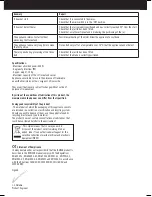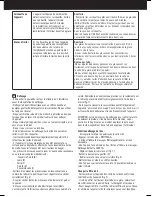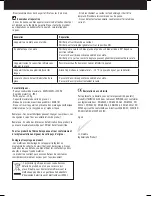
Freezing more
than 24 hrs.
-
The content to be processed must be solid
throughout.
-Frozen food which is soft in the centre
causes the motor to function incorrectly
and affects the texture quality.
What to do:
-Freezing the food for at least 24 hours in a standard 4-star freezer.
-Freeze the food at between -20ºC and -22ºC to obtain correct texture
quality.
What not to do:
-Process frozen food that has not been completely frozen.
-Process frozen food which is not at -20ºC. The quality obtained may
be too soft.
Positioning the
blade and jug lid
- If the blade is incorrectly positioned this
may cause it to fall during the process. If
this occurs you will hear a loud noise.
- Not fitting the lid may contaminate the
system with food.
What to do:
-Position the blade and jug lid correctly.
-Check that the blade is well secured.
-Listen to the appliance for the first few seconds after start-up to
detect any loud noise.
What not to do:
- Never start the appliance if the blade and jug lid are not positioned
and well secured.
Cleaning the
appliance
-Cleaning the appliance
is simple and requires little work.
-The appliance has a cleaning function to
make complete cleaning easy.
What to do:
-Clean the blade and jug lid after each use.
-If you find excess leftover frozen food on the jug lid, clean the
appliance around the spindle with a damp cloth.
-Clean the appliance completely at the end of the day.
-If you have processed over-filled frozen food clean the appliance
completely.
Maintenance of
the blade
- Using a deteriorated blade (bent or with a
worn edge) can damage the appliance and
affect the texture quality.
What to do:
-If you detect wear on the edge of the blade request a genuine
replacement.
-If a paddle of the blade has become bent request a genuine
replacement.
What not to do:
-Process frozen food using a deteriorated blade.
Air filter
- The carbon filter helps to keep the
injected air clean and odourless.
What to do:
-Replace the air filter every 6 months to preserve its filtering
properties in order to prevent exterior smells and vapours from
affecting the frozen food.
Maintenance
of frozen food
vessels
-The metal frozen food vessels must be
kept in perfect condition to prevent damage
to the appliance and maintain the texture
quality.
What to do:
-Check the vessel before processing. It must be free of indentations
and deformations.
What not to do:
-If you use a frozen food vessel that requires excessive force to
position it in the appliance, it probably has an indentation or
deformation and must be replaced.
-Hitting the rim of the frozen food vessel with a spoon or other
utensils will deform the rim.
-Before freezing the food, when fitting the vessel lid check that it is
not pressing too hard on the food, as it could deform the vessel once
frozen.
Overheating of
the appliance
-The appliance has an overheating
protection element. After overheating, the
appliance will cease
to function for 15 minutes.
-If the protection is activated during
processing, this will be half done and the
blade will remain in the interior of the
frozen food vessel.
What to do:
-To prevent overheating, after having made 10 consecutive portions,
respect the rest period of 5 minutes.
-Check the correct status of the blade, that the edge is preserved and
that there is no bending of the paddles. Otherwise change it for a
genuine replacement.
If overheating has occurred:
-Make sure to reposition the blade correctly on the spindle before
processing again one the appliance has been re-established.
Summary of Contents for ROWZER
Page 2: ......
Page 3: ...A D E F G A1 A2 A3 A4 A5 I H C K A6 A7 B J...
Page 4: ...fig 1 fig 2 fig 3...
Page 5: ...fig 4 fig 5 fig 6...
Page 6: ...fig 7 fig 8 fig 9...
Page 43: ......
















































